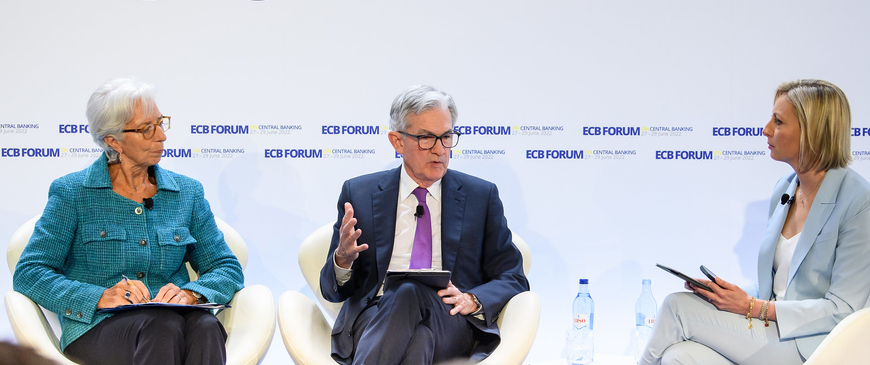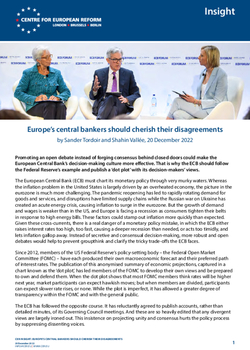
Europe's central bankers should cherish their disagreements
Promoting an open debate instead of forging consensus behind closed doors could make the European Central Bank’s decision-making culture more effective. That is why the ECB should follow the Federal Reserve’s example and publish a ‘dot plot’ with its decision-makers’ views.
The European Central Bank (ECB) must chart its monetary policy through very murky waters. Whereas the inflation problem in the United States is largely driven by an overheated economy, the picture in the eurozone is much more challenging. The pandemic reopening has led to rapidly rotating demand for goods and services, and disruptions have limited supply chains while the Russian war on Ukraine has created an acute energy crisis, causing inflation to surge in the eurozone. But the growth of demand and wages is weaker than in the US, and Europe is facing a recession as consumers tighten their belts in response to high energy bills. These factors could stamp out inflation more quickly than expected. Given these cross-currents, there is a real danger of a monetary policy mistake, in which the ECB either raises interest rates too high, too fast, causing a deeper recession than needed, or acts too timidly, and lets inflation gallop away. Instead of secretive and consensual decision-making, more robust and open debates would help to prevent groupthink and clarify the tricky trade-offs the ECB faces.
Instead of secretive and consensual decision-making, more robust and open debates would help to prevent groupthink and clarify the tricky trade-offs the European Central Bank faces.
Since 2012, members of the US Federal Reserve’s policy-setting body – the Federal Open Market Committee (FOMC) – have each produced their own macroeconomic forecast and their preferred path of interest rates. The publication of this anonymised summary of economic projections, captured in a chart known as the ‘dot plot’, has led members of the FOMC to develop their own views and be prepared to own and defend them. When the dot plot shows that most FOMC members think rates will be higher next year, market participants can expect hawkish moves; but when members are divided, participants can expect slower rate rises, or none. While the plot is imperfect, it has allowed a greater degree of transparency within the FOMC and with the general public.
The ECB has followed the opposite course. It has reluctantly agreed to publish accounts, rather than detailed minutes, of its Governing Council meetings. And these are so heavily edited that any divergent views are largely ironed out. This insistence on projecting unity and consensus hurts the policy process by suppressing dissenting voices.
Instead, the ECB should adopt its own summary of economic projections. Each council member would disclose their inflation and growth forecast, and a commensurate path for central bank interest rates ahead of each monetary policy meeting. These would be released in an anonymised dot plot after the regular ECB press conference.
The advantages of the ECB introducing a dot plot would outweigh the drawbacks.
First, it would improve the quality of the debates and arguments within the ECB and outside it. Instead of following the herd, each member of the ECB’s Governing Council would be prompted to develop their own coherent view and speak out in its favour. Such a process would broaden the available arguments in the debate, sharpen the choices between them and, through disagreement, make it likelier to find the best course of action.
Second, a dot plot would help to tilt the nature of the discussion in the ECB’s boardroom from the pursuit of consensus to that of the most convincing view. Quicker and more decisive committee-based decision-making would curb the pressure for consensus. The ECB has avoided as much as possible voting on policy decisions, despite having procedures in place for votes. The need to reach consensus slowed the ECB down in starting quantitative easing during the euro crisis a decade ago – a delay that came at a great economic cost.
Third, a dot plot would make the ECB’s communications more transparent. There is value in the public understanding why some ECB governors change their minds, and the extent to which they disagree with one another. Communicating the different scenarios under debate would help shield the ECB from easy criticisms from either the hawkish or the dovish commentariat. A dot plot could have shown that a growing number of decision-makers wanted to raise rates earlier during the inflation surge last year, improving the predictability and credibility of the ECB.
The @ECB should follow the @federalreserve example and publish a ‘dot plot’ with its decision-makers’ views to increase the effectiveness, predictability and credibility of eurozone monetary policy.
There would of course be some drawbacks to this openness. It could expose rifts between the ECB’s decision-makers and the diverse countries they represent, fuelling concerns about the stability of the single currency. But the currency union is mature enough to withstand normal disagreements over monetary policy, the same way it manages disagreements about fiscal policy.
Another concern is that the dot plot could easily be misconstrued as a forward guidance, tying central bank officials to a policy path even when economic circumstances change. To mitigate this risk, the ECB could learn from the experience of the Fed in designing its dot plot, for example by only forecasting policy rates over a short 12-month horizon.
There is also a risk that a dot plot simply does not have any effect. Decision-makers could merely hold some of their deliberations before they prepare their dots and meet in Frankfurt. The dot plots are only powerful if central bank governors use them as a device to clarify and communicate their underlying reasoning. The introduction of a dot plot therefore needs to be part of a wider shift towards a decision-making culture that embraces discussion and dissent. Voting on key or controversial decisions could be another step in that culture shift.
Ultimately, whether the ECB President is a consensus-builder, like Christine Lagarde, or employs a more assertive style, like Mario Draghi, they should encourage open debate between council members to enhance accountability and transparency. The ECB cannot dispel the great uncertainty it faces, but it can improve how it navigates that uncertainty.
Sander Tordoir is senior economist at the Centre for European Reform and Shahin Vallée is co-head of the geoeconomics programme at the German Council on Foreign Relations.


Add new comment